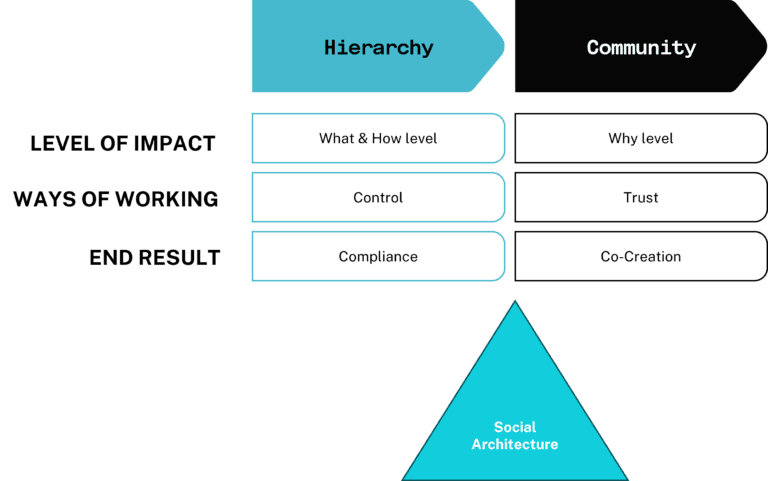Did you know that a mere 3% of individuals in your organisation are responsible for distributing more than 85% of its communication?
This remarkable insight comes from Innovisor.com, which, after extensive analysis, has highlighted the limitations of traditional top-down communication strategies. In the top-down communication model, information trickles down from senior leadership to the rest of the organisation. However, the research suggests that relying solely on this method is increasingly ineffective for driving organisational change.
The question then arises: how do you identify the right people to engage for maximum impact?
It’s common for “Change Champions” to be chosen based on availability rather than their true potential to influence others. Historically, change managers turned to the formal power structures illustrated in organisational charts to select these champions.
Yet, at Exent, we understand that a successful change strategy involves more than just formal structures. It requires a mix of formal and informal approaches to make an impact truly.
Influencers
In Agile Change Galoppin analysed Social Architecture to determine the need for a balancing act between top-down versus community communication and engagement.

We all know that person in an organisation who seems to know everyone and every business process. They are the great connectors, with social capital, trust and rapport within your business. They can make or break your change efforts. They are often without titles or senior leaders but getting them onside is crucial. They are brilliant listeners who value one-on-one conversations. Surprisingly, they are also often introverts.
How do we find them?
Network Analysis is the first step.
Network analysis is used to analyse many different types of networks such as culture, nature, brains, organisms’ economies and ecologies. In this context, it is used to identify the 3% that will be essential to the success of your change effort.
They will require an understanding of the change. They have the networks to communicate it, share information and collaborate where necessary for your project’s success. They will also maintain the change, long after the project is completed and ensure the change is institutionalised.
Next, you’ll need to identify communities that can make things happen. This could be an analysis of Yammer channels, LinkedIn, or you might see who’s making the most noise on Teams’ channels. Who is developing a lot of content on your intranet, or who has been in the business for a long time?
Network Analysis may even be able to be digitally performed by your system administrators to see who’s sending and receiving the most emails/messages etc. In addition, platforms like AvePoint or Swoop can analyse your entire Microsoft suite.
More often than not, seasoned leaders and change practitioners do something that’s called “productive loitering”. In change management, “productive loitering” is a strategic approach to uncovering latent influencers within an organisation. By engaging in casual conversations in communal spaces such as the coffee shop or kitchen, leaders can identify and enlist key individuals who wield informal power, securing essential advocacy for their change initiatives.
Take notice. Who do people go to with questions or to gain opinions from? If you ask around, you’ll hear words of respect and you’ll rarely hear anything negative about them.
At Exent we are experts in Network Analysis and uncovering your 3%. We understand the key steps to producing an informed NA are:
Define the Network
Determine the entities (nodes) and their relationships (edges) within your network.
Collect Data
Gather data from various sources, including direct observations and digital interactions, to populate your network nodes and edges.
Build the Network Graph
You can whiteboard this or use software (e.g., NetworkX, Gephi) to create a visual graph representing nodes (entities) and edges (connections).
Enrich the Network
Add detailed attributes to nodes and edges based on collected data to highlight important metrics like interaction frequency and relationship strength.
Analyse the Network
Apply metrics such as degree centrality, betweenness centrality, closeness centrality, and eigenvector centrality to identify influential nodes.
Visualise the Network
Employ visualisation tools to create graphical representations of your network, aiding in the identification of patterns and influential nodes.
Interpret Results
Analyse the visual and quantitative data to pinpoint hidden influencers and understand their roles within the network.
Validate Findings
Confirm the influence and roles of identified nodes through additional research or external data.
Report Findings
Summarise and present your findings using clear visuals and succinct descriptions to communicate the influence of landscape effectively.
Final thoughts
Once you uncover these people, it is important not to try and control them. Consider their values and purpose and ensure your change initiatives align with them. Show genuine gratitude for their efforts in supporting your change.
Understanding and harnessing the power of key influencers is essential for those looking to drive effective change within their organisations. Start by rethinking communication strategies to include bottom-up elements. Then, consider engaging with experts like Exent to uncover and utilise your company’s hidden influencers. Implementing these strategies is the key to achieving lasting change.



